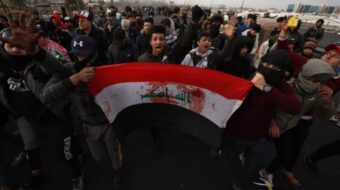
From 2004 to 2011, the Pentagon covered up injuries to U.S. troops in Iraq from chemical weaponry supplied to Saddam Hussein by the U.S. and other countries in the 1980s, according to a disturbing, detailed report in the New York Times last week. The affected troops were often denied proper treatment, were told by higher-ups not to report the real cause of their injuries, and were denied medals for their often heroic actions in trying to decontaminate the toxic materials they had uncovered during their duties in Iraq.
Why the mistreatment of U.S. soldiers, and why the cover-up?
The Bush administration claimed, in the lead-up to the 2003 U.S. invasion, that Iraq had weapons of mass destruction that posed an imminent threat to Americans. But as we know, there were no nuclear weapons, and the actual chemical weapons that U.S. troops encountered in Iraq – artillery shells, bombs, and other weaponry containing sarin, mustard and nerve gas – were rusting leftovers from the 1980-1988 Iran-Iraq war, buried or dumped in places like Saddam Hussein’s notorious Al Muthanna security center.
That area is now controlled by the so-called Islamic State, raising the possibility that the vicious group could use the chemicals in its onslaught against Iraq and Syria.
In the Times article, headlined “The Secret Casualties of Iraq’s Abandoned Chemical Weapons,” reporter C. J. Chivers wrote, “The United States had gone to war declaring it must destroy an active weapons of mass destruction program. Instead, American troops gradually found and ultimately suffered from the remnants of long-abandoned programs, built in close collaboration with the West.”
This is confirmed in a 2011 draft report by Anthony Cordesman and others at the Center for Strategic and International Studies on U.S. competition with Iran, which said the Iran-Iraq war became “the focal point of U.S.-Iranian competition,” with the following result: “Iraq is removed from list of states sponsoring terrorism (1982) and the US begins arming Iraq against Iran, including ‘dual-use’ technology, and industrial goods for missile, chemical, biological and nuclear weapons programs and weapons.”
A People’s World article by Tim Wheeler in 2002 noted the role of Cold War and oil politics in the Reagan administration’s actions.
In 2003, a Washington Post article by reporter Michael Dobbs was headlined “U.S. Had Key Role in Iraq Buildup Trade in Chemical Arms; Allowed Despite Their Use on Iranians, Kurds.” The article appears to be no longer available at the Washington Post website, but is available here.
Dobbs reported that U.S. involvement with Saddam Hussein “included large-scale intelligence sharing, supply of cluster bombs through a Chilean front company, and facilitating Iraq’s acquisition of chemical and biological precursors.” Dobbs called it “a topical example of the underside of U.S. foreign policy … in which deals can be struck with dictators, human rights violations sometimes overlooked, and accommodations made with arms proliferators” to advance a certain agenda.
The agenda in this case was the U.S. perception that the 1979 revolution in Iran and ascendancy of extremist Shiite Islamism there threatened “the fall of pro-American states such as Kuwait, Saudi Arabia, and even Jordan – a Middle East version of the domino theory in Southeast Asia.”
“That was enough to turn Hussein into a strategic partner” for the U.S., Dobbs wrote.
The 1925 Geneva Protocol prohibits the use of chemical and biological weapons in war. The 1997 Chemical Weapons Convention outlaws the production, stockpiling, and use of chemical weapons and their precursors.
Nevertheless, Dobbs reported, “The administrations of Ronald Reagan and George H.W. Bush authorized the sale to Iraq of numerous items that had both military and civilian applications, including poisonous chemicals and deadly biological viruses, such as anthrax and bubonic plague.”
Last week’s Times article mentions two U.S. firms that in 1987 supplied “hundreds of tons” of a chemical that can be used to make toxic mustard gas. Documentation attached to the article identifies the firms as commercial chemical companies Technalloy Corp., then based in San Jose, Calif., in association with Cardinal Stabilizer, now Cardinal Chemicals, based in North Carolina, and Alcolac International, then based in Baltimore.
But the Times article does not mention Dow Chemical (of Agent Orange notoriety), which in 1988 sold $1.5 million worth of highly toxic pesticides to Iraq, according to Dobbs. Dow claimed these chemicals could not be “weaponized.”
Another well-known firm, Bechtel Corp., served from 1988 to 1990 as engineering consultant for a $2 billion Iraqi military-related petrochemical complex being built by the Saddam Hussein regime.
They were among a long list of companies who received U.S. government licenses to export such “dual use” chemicals, equipment and services to the Iraqi dictatorship.
In addition to war with Iran, the Saddam Hussein regime was battling resistance to its rule in Iraq’s Kurdish region. Just months after the 1987 chemical shipments, in March 1988, the Iraqi air force carried out a massive chemical attack against the Iraqi Kurdish city of Halabja, in which some 5,000 men, women and children were killed.
Following the 1990-1991 Gulf War, in October 1992 the Senate Banking Committee held an investigation into what became known as Gulf War syndrome, illnesses suffered by U.S. soldiers in the 1990-1991 war with Iraq, and into the massive U.S. military-related exports to Saddam Hussein. The committee found that: “The United States provided the Government of Iraq with ‘dual use’ licensed materials which assisted in the development of Iraqi chemical, biological, and missile- system programs, including: chemical warfare agent precursors; chemical warfare agent production facility plans and technical drawings (provided as pesticide production facility plans); chemical warhead filling equipment; biological warfare related materials; missile fabrication equipment; and, missile-system guidance equipment.”
Yet then-President George H.W. Bush had flatly claimed on several occasions during that year’s presidential election campaign that the U.S. had not “enhanced” Saddam Hussein’s nuclear, chemical or biological weapons capability. To admit to the actual U.S. role would have meant admitting to violation of international law and humanitarian principles by the Reagan and Bush I administrations, and to callous mistreatment of U.S. military personnel as part of an effort to conceal those actions. The Pentagon long refused to recognize Gulf War syndrome, suffered by thousands of U.S. troops, that is widely believed to be a result of exposure to toxic chemicals in the war.
No wonder that a decade later, his son, President George W. Bush, and top administration officials, many of whom had served under Reagan and Bush I, again tried to cover up the U.S. role as chemical weapons merchants for Saddam Hussein, and again callously mistreated U.S. soldiers suffering the effects of those chemicals.
Photo: An Iranian soldier wearing a gas mask during the Iran-Iraq War. Wikipedia










